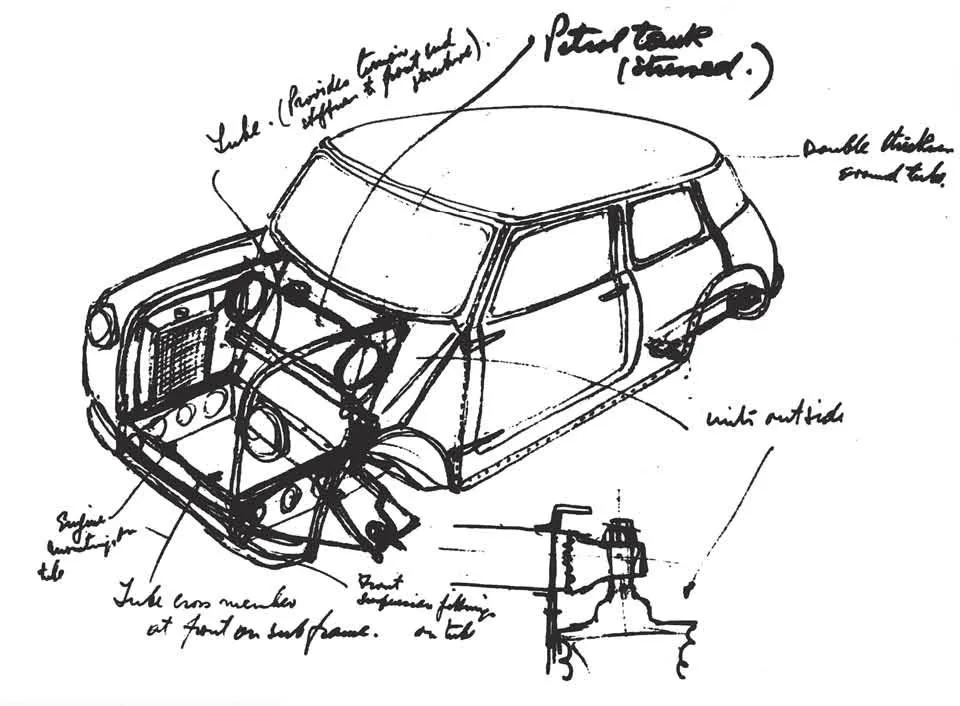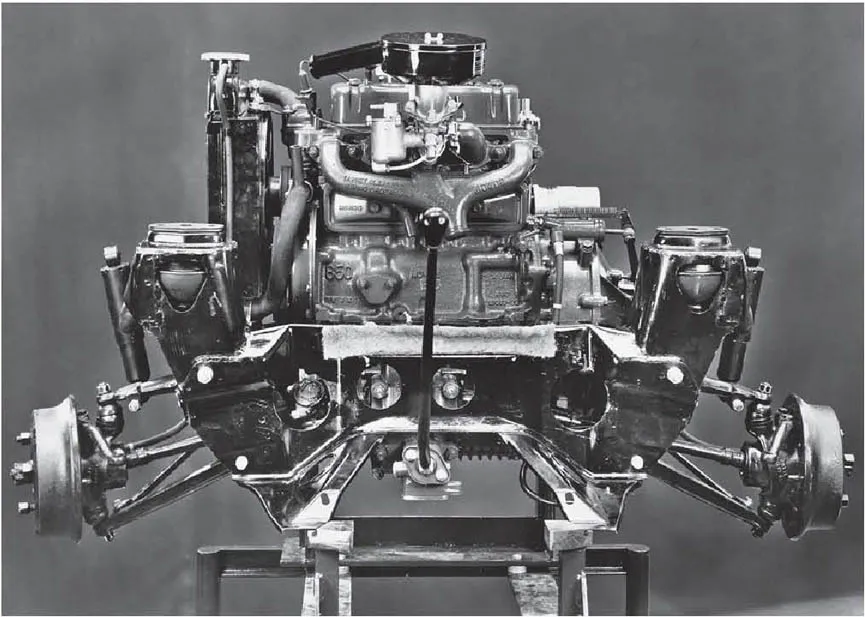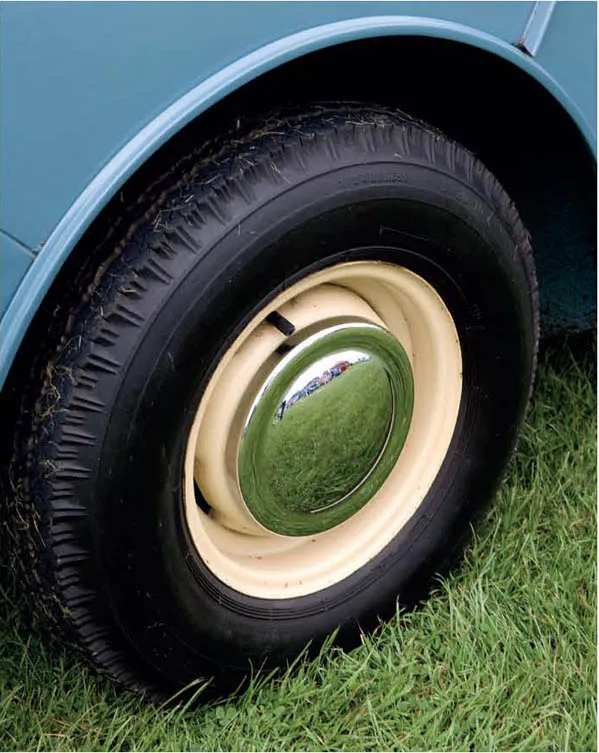![]()
PART I
WHERE IT ALL BEGAN
![]()
CHAPTER ONE
BMC’S MINI
The Mini was originally a product of the British Motor Corporation (BMC), which later became a part of British Motor Holdings (BMH) in 1966, and eventually merged with Leyland Motors in 1968 to form British Leyland. It wasn’t until 1969 (ten years after its birth) that Mini became an automotive marque in its own right. During the late 1980s, British Leyland was demolished and Mini joined Rover Group. In 1994, Rover Group was acquired by BMW, which the brand later dissolved in 2000, while retaining the Mini/MINI brand. Today, the MINI division is led by Sebastian Mackensen.
It took just one man to design the ultimate small family car, the very machine that, thanks to its transverse-engine, front-wheel-drive layout, is capable of seating four adults, has a luggage compartment (albeit small) and the ability to bring a smile to each and every one of its drivers’ faces. Little did he know that this little car would go on to become an iconic symbol of British heritage: the Mini was a motoring legend both on the road and on the race circuit.
Britain’s small car was born in response to an economic and political crisis, and it soon became a little car that gave mobility to millions. Sir Alec Issigonis’s baby was created in response to the Middle East crisis when, in September 1956, Colonel Nasser decided to nationalize the Suez Canal and use the Arabs’ control of the world’s oil supplies to hold the rest of the word to ransom. When the Arabs closed their oil pipeline across the Mediterranean, in the ensuing war they blew up the Syrian pipeline that provided 20 per cent of Britain’s petrol supply. This resulted in petrol rationing hitting the UK in December that year, and inevitably, a newly found popularity for small cars across Europe.
Original sketch of the Mini prototype by Alec Issigonis in 1958. NEWSPRESS
A bird’s-eye sketch of the Mini 850, by Alec Issigonis in 1958. MAGIC CAR PICS
Alec Issigonis stands proudly between the Austin Mini 850 cars in 1959. MAGIC CAR PICS
In the period between 1956 and 1957, the sales of 900 to 1000cc cars rocketed. This explains the appearance of German bubble cars in the UK, which could achieve more than 40 miles per gallon (7ltr/100km) – the ideal statistic for families living in a petrol-starved period. At the end of 1955, Leonard Lord invited Issigonis to rejoin BMC after three years at Alvis Motors. Lord Leonard quite frankly despised bubble cars, and is reported to have said to Issigonis in March 1957: ‘God damn these bloody awful bubble cars. We must drive them off the streets by designing a proper small car.’ From that point, BMC’s new car development programme changed from replacing the Morris Minor to producing a new small car.
An engineering team of four draftsmen, a group of student engineers and three talented men, including Chris Kingham from Alvis Motors, Jack Daniels who helped produce the Minor, John Sheppard who was responsible for the design, and Issigonis himself, set about designing and defining the Mini – the XC9003, which later became project ADO15 when development moved to the Austin HQ at Longbridge. Issigonis saw front-wheel drive as the powertrain for his future cars, and ADO15 would become the first practical four-seater crammed into a small package to reach production.
Up until 2015, John Sheppard was the last surviving member of the classic Mini design team. Under the direction of Issigonis, he led the construction of BMC’s revolutionary car in the late 1950s. Sheppard was largely responsible for the structure of the body, as well as the Mini’s many cost-saving features. Essentially, he was there to translate Issigonis’s scribbles into more credible designs. Every cost-saving feature, including the little car’s door bins, which were large enough to hold gin and vermouth bottles to mix Issigonis a dry Martini, were designed by Sheppard. But he didn’t always have the final say when it came to making official decisions: in one difference of opinion he lost an argument with Issigonis over the construction of the floor, and was forced to draw up a design that he knew would leak. To put into perspective just how much water the little Minis originally took on board, one road-test journalist returned from an outing with a goldfish lodged in one of those signature door pockets. To combat the floor-leaking issue, every Mini was supplied with a pair of Wellington boots as standard. Thankfully, that wasn’t the only resolution, and eventually Sheppard was given authority to redesign the underbody of the Mini to stop the water gushing in, just as he had originally intended.
The longitudinal section of the Morris Mini-Minor and Austin Se7en 1959. NEWSPRESS
Issigonis had already proved with his work on the Morris Minor replacement that he could fit an engine and gearbox into a space of just 2 feet (60cm) of a car’s entire length. But when the Mini was destined to be a narrow vehicle, it was difficult to see how the package would be accommodated between the Mini’s wheels without compromising the steering lock. The first attempt at resolving this problem was for an A-Series engine to lose two cylinders, creating an in-line, 2-cylinder, 500cc engine. As would be expected, the engine lacked ‘oomph’ and was far too rough for the job. Issigonis resolved the issue by mounting the gearbox underneath the engine, as part of an in-sump arrangement – a crucial part of the first Mini mock-up. By July, just four months after the development began, the first prototype was up and running. ADO15 used a conventional BMC A-Series, 4-cylinder, water-cooled engine. The Mini’s spacesaving transverse-engine, front-wheel-drive layout meant that 80 per cent of the car’s floorpan could be used to seat passengers and store luggage, therefore influencing a generation of car makers.
Weight and length were critical in the development of the Mini. The fact that the first prototype was 6mm (¼in) over 3m (10ft) long irritated Issigonis immensely. The team were eventually able to make the Mini 45kg (100lb) lighter than the Austin A35, which would inevitably become a key factor in ensuring that the car retained competitive fuel consumption figures, which would later prove difficult to beat for the likes of British Leyland. It is rumoured that in July 1957 the BMC chairman Leonard Lord first drove the prototype around the Longbridge plant, instructing Issigonis to ‘build the bloody thing’. A second prototype was soon born. Both cars were disguised with Austin A35 grilles and based at Cowley in the hands of engineers from Morris Motors, who would later play a significant role in the development of all the front-wheel-drive cars to follow in the footsteps of the Mini.
Front axle and engine of the Morris Mini-Minor and Austin Se7en 1959. NEWSPRESS
ADO15 used a conventional BMC A-Series, 4-cylinder, water-cooled engine. MAGIC CAR PICS
Many were unsure as to why Issigonis pushed the development of 10-inch wheels. MAGIC CAR PICS
The Mini featured a basic but revolutionary interior with space for four adults. MAGIC CAR PICS
Although the little Minis shared a number of design weaknesses and would later undergo a range of engineering tweaks, the Mini was finally on its way to production. A big question mark hovered above the Mini’s minute 10in wheels for a long period of time. Most people couldn’t understand the purpose in creating a smaller road wheel, but Issigonis pushed the development of the small car by working with Dunlop to produce the smallest road tyre. The industry average rim size at the time sat at 16–17in. Nonetheless, the Mini needed small tyres to optimize cabin space. Dunlop eventually produced 5.20in tyres that appeared on the Mini.
Joint managing ...










